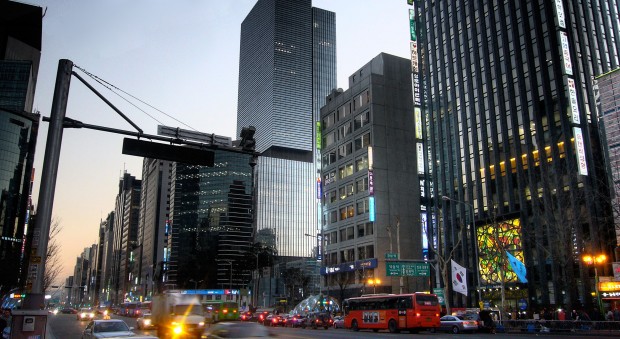In town, without my car
Park Moo-jong – The Korea Times
Ever since the world’s first automobile, the Patent-Motorwagen (motor car), invented by Karl Benz, rolled out on the Ringstrasse (ring road) in the German city of Manheim on July 3, 1886, the world has had a love-hate relationship with the modern convenience.
Today, 130 years later, the world appears to be unable to escape the pollution, noise and danger that over one billion motor cars produce globally, with one of the most critical questions being how to beat gridlock.
Everybody knows the answer: Reduce the use of the motor vehicles. Then, how?
Yesterday, September 22, was World Car Free Day, one day a year set aside to leave cars at home and use bikes and public transport or walk instead.
Since the first national campaign to encourage people to be less dependent on their cars and try alternatives in Britain in 1997, global Car Free Day was launched in 2000 and South Korea joined the environmental movement in 2001
Seoul, which is notorious for the round the clock traffic congestion, set Sunday the day after tomorrow as Car Free Day, and is operating the month’s fourth week from Sept. 19 to 25 as “Car Free Week.”
To “celebrate” yesterday’s World Car Free Day, many cities across the nation held various events. For instance, Seoul featured Mayor Park Won-soon’s cycling to City Hall from Anguk Subway Station near his official residence in the morning.
On Sunday, the Seoul City administration will restrict the operation of motor vehicles on the 1.1 km section between Gwanghwamun (Gwanghwa Gate of Gyeongbok Palace) and City Hall as the Car Free Day main event. Of course, there will be many other shows and exhibitions to promote the campaign in the area.
According to The Washington Post, the event “promotes improvement of mass transit, cycling, and walking, and the development of communities where jobs are closer to home and where shopping is within walking distance.”
But with the ever-worsening traffic in big cities across the globe, especially in Seoul, one day of no cars a year and then a return to “normal” life proves ineffective in encouraging people to park their cars at home on a more permanent basis.
City planners and politicians seem to have no option but to ask citizens to ride bikes and use public transit. But here bikes are not yet a good option due to too many risks and obstacles.
Policymakers have to come up with more concrete programs to help people know the benefits of cycling and should build special and safer lanes for bikes and adopt successful programs from some other countries such as the Netherlands, the paradise of bicycle riders.
Traffic problems are getting worse in the big cities of Seoul, Busan and Daegu. On top of that, air pollution caused by the exhaust gas from millions of cars stranded in gridlocks has already become public enemy No. 1 threatening people’s health.
Adding insult to injury is the sharp increase of diesel cars and cheating car makers like Volkswagen under a bizarre government policy.
It is still vivid in our memory that we could successfully stage the 1988 Seoul Olympics, the 2000 ASEM summit, and the 2002 World Cup partly thanks to the “odd-even system” under which vehicles with odd or even numbered plates were driven on alternate days, and penalties were imposed on those who violated the “temporary” rule.
Many still remember the sweetness of the system, with as much as 85 percent of drivers having faithfully followed the rule.
In 2004, Athens followed suit for its successful Olympics and four years later Beijing was also triumphant by implementing the system to half the number of motor vehicles.
Policymakers need to consider bolder measures to help solve traffic problems. Compared to the days when the odd-even system was introduced, we have much better conditions today.
For instance, major cities are proud of their good subway systems. Seoul, in particular, is second to none in the world in terms of its network.
The system is so good that we can recommend people to ride subways if they want to be on time for their appointments during the bumper-to-bumper congestion.
The bus-only lanes in the center of the street are also a good model for big cities suffering from all-day long gridlock.
But the latest picture of the city testifies to poor improvement in solving the problem only with the public transport system, although it is one of the best in the world.
As far as traffic problems are concerned, traffic experts and officials need to listen to taxi drivers who crisscross the city, fighting desperately the ever worsening congestion.
On Tuesday, I traveled by taxi to Kyobo Bookstore in Gangnam (south of the Han River) from Daehakno Street in Gangbuk (north of Han River) around 11 a.m.
I asked the cab driver, aged around 65, “Do you have any idea how to ease the present traffic jam as a veteran cab driver and what do you think of the World Car Free events?”
“The events are just a mere display. Rather, they paralyze the traffic in the heart of city,” he complained. “And if I could recommend something, the odd-even system may be too radical. Restricting car owners from using their cars one day out of five will be effective, and police should exert more efforts to crack down on illegally parked cars.”
Since last year, I seldom drive my car. Instead, I ride the subway to arrive on time for my appointments. Furthermore, it’s free for people over 65. Park your car at home and go to town without it.






















































